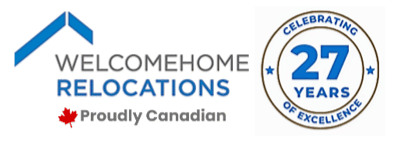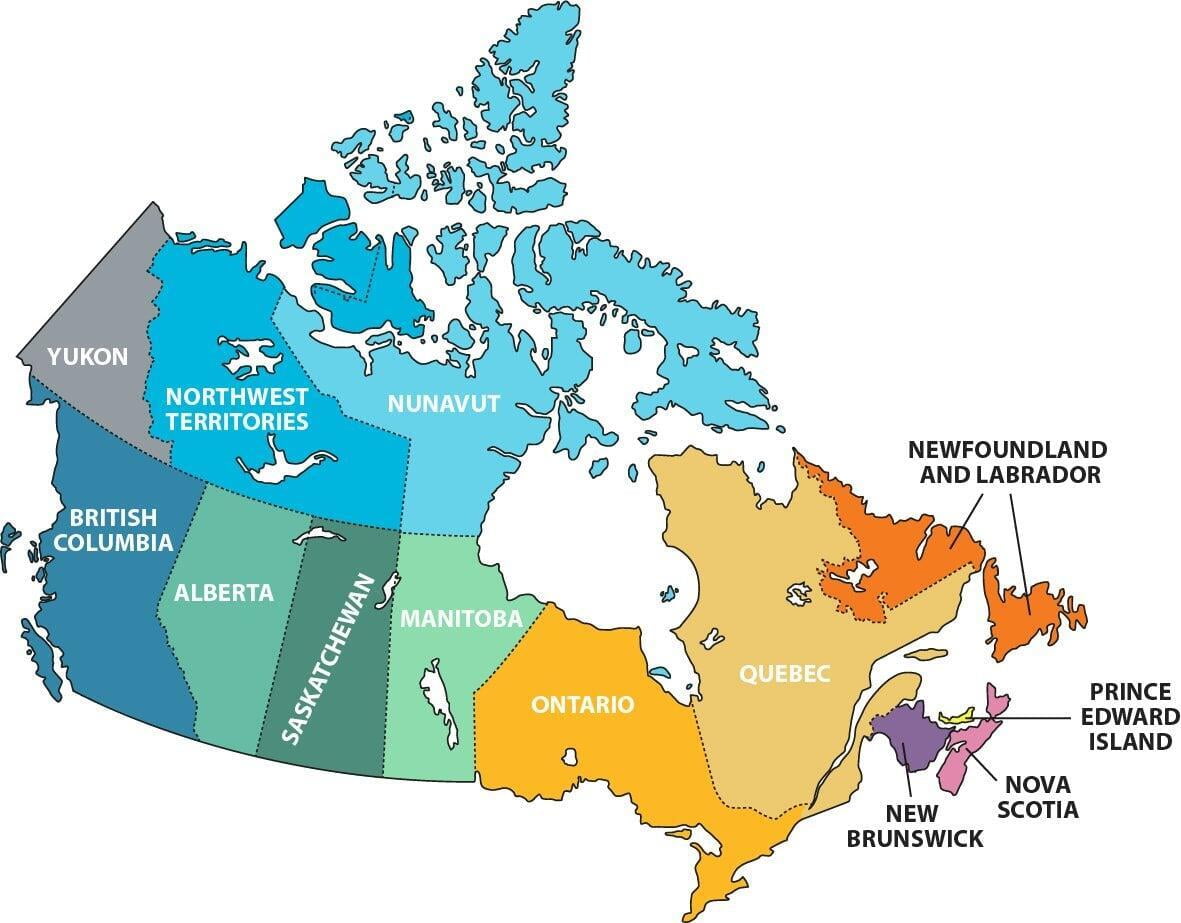
Canada is the second largest country covering an area of 10 million square kilometres. Three oceans border Canada: The pacific Ocean in the west, the Atlantic Ocean in the east and the Arctic Ocean to the north. Canada has over 200,000 killometres of coastline and shares two borders with the United States: a very long border in the south and another long frontier in the northwest.
The current population of Canada is 38,067,903.
Due to its large size, Canada has many different types of landscapes. Canada offers areas of high mountains, different types of forests, prairie grasslands, and arctic tundra where the ground is permanently frozen.
Canada has 10 provinces and three territories each with its own capital city.
The capital city of Canada is Ottawa.
| Region | Province/Territory | Capital City |
Atlantic Provinces | Newfoundland and Labrador Prince Edward Island Nova Scotia New Brunswick | St. John's Charlotte Halifax Fredericton |
| Central Canada | Quebec Ontario | Quebec City Toronto |
Prairie Provinces | Manitoba Saskatchewan Alberta | Winnipeg Regina Edmonton |
| West Coast | British Columbia | Victoria |
| North | Nunavut Northwest Territories Yukon Territory | Iqaluit Yellowknife Whitehorse |
Canada has two official languages: English and French. English is most commonly spoken across Canada except for in Quebec.
French is the main language in Quebec and in some areas of Ontario, New Brunswick and Manitoba.
All official federal government services, publications and documents are available in both English and French. By law, the federal government must provide services throughout Canada in both English and French.

Government of Canada
Canada is a constitutional monarchy with Elizabeth II, Queen of Canada, as head of state. The country is a parliamentary democracy with a federal system of parliament government and strong democratic traditions.
In Canada, there are 3 levels of government – federal, provincial or territorial, and municipal.
Each level of government has different responsibilities.
Federal government (the Government of Canada)
Highest level of Canadian government and is based in Ottawa, the capital city of Canada. The Federal government is responsible for national and international matters, such as national defense, foreign affairs, currency, banking, federal taxes, postal services, and criminal law. In general, the federal government deals with laws that affect the whole country. The federal government is led by the Prime Minister. The current Prime Minister is Justin Trudeau (pictured right).
Provincial and territorial governments
There are 10 provinces and three territories. Each is led by a Premier and has its own elected legislature which has the power to change its laws and manage its own public lands. They are responsible for such things as education, health care and highways.
Municipal (local) governments
Municipal (cities, towns, and villages) government is the governing body of a city, town or community. They oversee local issues including firefighting, city streets, water systems, police, public transportation, etc.
Canada's National Anthem
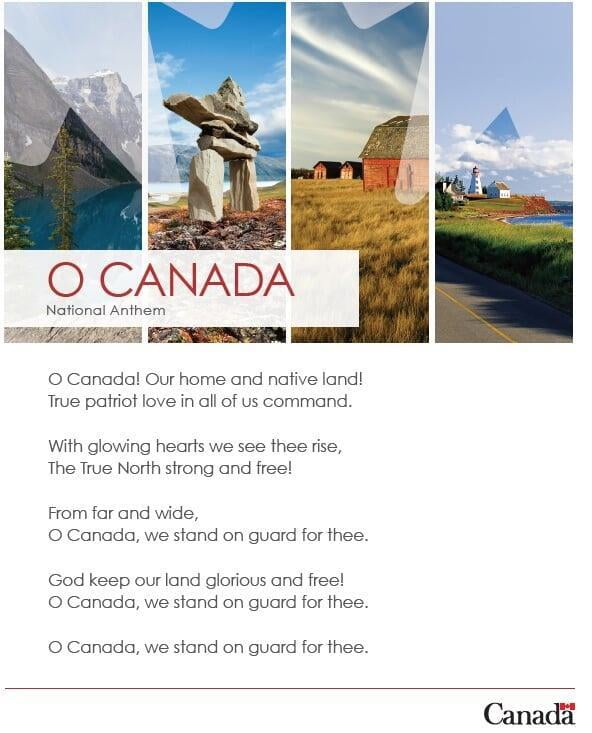
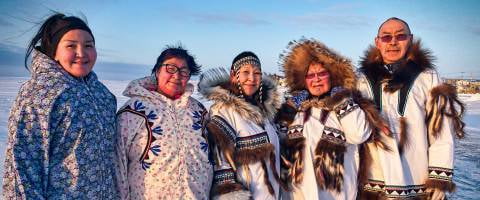
Indigenous Culture in Canada
"Indigenous peoples" is a collective name for the original peoples of North America and their descendants. Often, "Aboriginal peoples" is also used.
The Canadian Constitution recognizes 3 groups of Aboriginal peoples: Indians (more commonly referred to as First Nations), Inuit and Metis. These are 3 distinct peoples with unique histories, languages, cultural practices and spiritual beliefs.
More than 1.67 million people in Canada identify themselves as an Aboriginal person.
First Nations
There are more than 630 First Nation communities in Canada, which represents more than 50 Nations and 50 Indigenous languages.
Inuit
The Inuit are are Indigenous peoples of the Arctic. The word "Inuit" means "the people" in the Inuit language of Inuktitut.
Métis
Please click Métis to learn more about the communities in Canada.
To learn more about Indigenous arts, culture and heritage in Canada that are woven into the fabric of Canada, please visit: Indigenous arts, culture and heritage
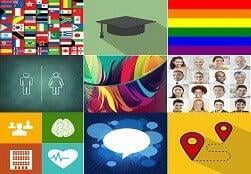
Inclusiveness
Canada actively promotes inclusion and respect for diversity at home and abroad. Diversity is a natural characteristic of every society. Canada recognizes diversity as a source of strength and works to champion inclusive attitudes and encourage the adoption of inclusive approaches that lead to the full and meaningful participation of all.
Inclusion is a path to peace and prosperity
Practical strategies to address complex global challenges require the consideration of social, economic, cultural and civic inclusion. Excluding members of society from full participation due to prejudice, discrimination or other barriers causes everyone to suffer. Inclusive societies that take full advantage of their diversity are more innovative, creative, dynamic, resilient and prosperous.
Canada values inclusion.
Inclusion is not just the smart thing to do; it is also the right thing to do. Canada’s history has many uneven chapters, but Canada has made the choice to become a more inclusive country. A majority of Canadians now embrace policies such as bilingualism and multiculturalism that reflect Canada’s unique approach to inclusion. Canada’s journey on the path towards National Reconciliation is another manifestation of the desire to overcome past injustices and move towards a more inclusive society.
Speaking up for inclusion.
On the world stage, Canada reflects the value of inclusion in our bilateral relations, in our discussions with other states and through the efforts of our missions and embassies around the world. Canada also promotes inclusion and respect for diversity through the United Nations and other multilateral fora as an animating principle in our global rules-based system of security, international cooperation, trade and support for human rights.
“In the face of complex global challenges, Canada will continue to champion diversity, acceptance and compassion on the world stage. We cannot build a better world unless we work together, respect our differences, protect the vulnerable, and put people at the heart of the decisions we make.”
—Rt. Hon. Justin Trudeau, Prime Minister of Canada
In Canada, both federal and provincial or territorial laws protect the rights and freedoms of individuals. The Canadian Constitution includes the rights and freedoms to which Canadians are entitled in a free and democratic society. The Constitution guarantees certain political rights to Canadian citizens. It also guarantees civil rights to everyone in Canada.
The Canadian Constitution protects:
-- The freedom to express your beliefs and opinions freely (including through free press);
-- The freedom to associate with anyone you wish and gather peacefully with other people;
-- The freedom to practice religion;
-- The right to live anywhere in Canada;
-- The right to protection from unlawful or unjust arrest or detention by the government because in Canada every individual is equal before and under the law. You also have the right to due legal process under Canadian law. This means that the government must respect all your rights
under law;
As a resident of Canada, you benefit from all the rights listed above and more.
Rights come with responsibilities
People who live in Canada are expected to understand and obey Canadian laws, allow other Canadians to enjoy their rights and freedoms and help preserve Canada's multicultural heritage.
It is also important for Canadians to become informed about politics and help to improve their communities and the country.
Citizens of Canada have other rights and freedoms, such as the right to vote in elections. To learn about these rights, see the Canadian Charter of Rights and Freedoms.
The Canadian Human Rights Act
The Canadian Charter of Rights and Freedoms is part of Canada’s Constitution and protects you from the moment you arrive in Canada. It sets out the values that Canadians live by and describes the kinds of personal human rights and freedoms we can expect in this country. Some of those rights and freedoms include:
- The right to life, liberty and personal security
- Freedom of conscience and religion
- Freedom of thought, belief, opinion and expression, including freedom of the press and other media
- Freedom to hold peaceful meetings
- Freedom to join groups
- Protection from unreasonable search or seizure and unjustified detainment and imprisonment
- The right to be presumed innocent until proven guilty
- The right to retain and instruct counsel (a lawyer) without delay
- The right to a fair trial, through due process of law
- The right to equal protection and benefit under the law, without discrimination
The purpose of this act is to promote equality and prohibit discrimination. In this law discrimination can include race, nationality or ethnic origin, colour, religion, age, sex, sexual orientation, marital status, family status, disability and conviction for which a pardon has been granted. At work, no one should be held back from a promotion, be refused employment, or have their employment ended because of discrimination.
Canadian Law
Newcomers to Canada often bring their idea about the law and legal system (and how it works) from their own countries. It is very important that you understand the laws and legal system in Canada.
Canada's legal and political system come from the rights and freedoms of the British system. In Quebec, parts of the legal system comes from France.
The courts are separate from the Government. Canadians elect their government who then make the laws.
In Canada, the law applies to everyone, including: Police, Government and public officials. Canadian laws recognize and protect basic rights and freedoms, such as liberty and equality.
Public law and private law
Law can be divided into public and private law.
Public laws set the rules for the relationship between a person and society and for the roles of different levels of government. This includes Criminal, Constitutional and Administrative.
Private or Civil Law deals with the relationships between people. Civil laws set the rules for: Contracts, Property Ownership, Rights and duties of family members, and Damage to someone or their property caused by others, and so on.
Courts
Courts in Canada help people resolve disputes fairly and within the law. Most people settle their differences outside of court (for example, through mediation or arbitration).
Police
The police in Canada keep people safe and enforce the law. There are different types of police, including Federal, provincial, territorial, and municipal police forces. Police are there to help you if you have been the victim of a crime. In most locations across Canada, the emergency number for police, fire and ambulance is 911.
You should call the police if you:
- Are the Victim of a crime
- See a crime taking place
- know about criminal activities
If the police question or arrest you, do not resist. Under Canadian law, you are presumed innocent until proven guilty. Be calm, speak clearly. If you are detained by the police, you have the right to know why. You have the right to have a lawyer present and a translator present (if you need one). It is a serious crime to try to bribe the police by offering money, or gifts.
Taxes
Canadians pay a variety of taxes:
- Income Tax: income tax is deducted from each pay cheque and is used by governments to provide services such as roads, schools, and healthcare. (You can claim moving expense). Tax returns must be filed by April 30th each year.
- Goods & Services Tax (GST): The GST is a country-wide federal tax. The rate is 5% and is charged on most items except certain essentials such as groceries, residential rent, medical services and financial services. The tax is levied on each sale. (see HST)
- Provincial Sales Tax (PST): The PST varies from province to province
- Harmonized Sales Tax (HST): Many provinces combine the GST and PST to one tax called the HST.
- Excise Tax: Both the federal and provincial governments impose excise taxes on inelastic goods such as cigarettes, gasoline, alcohol and vehicle air conditioners.
- Property Tax: Each property is assessed based upon the current use and value of the land and this is the major source of revenue for most municipal governments.
Sales Tax by Province and Territory
Province /Territory | GST | PST | HST | Provincial Tax Information |
Alberta | 5% | n/a | n/a | |
BC | 5% | 7% | n/a | |
Manitoba | 5% | 7% | n/a | |
New Brunswick | n/a | n/a | 15% | |
Newfoundland | n/a | n/a | 15% | |
NWT | 5% | n/a | n/a | |
Nova Scotia | n/a | n/a | 15% | |
Nunavut | 5% | n/a | n/a | |
Ontario | n/a | n/a | 13% | |
PEI | n/a | n/a | 15% | |
Quebec | 5% | 9.975% | n/a | |
Saskatchewan | 5% | 6% | n/a | |
Yukon | 5% | n/a | n/a |
Special Dates In Canada
Event | Day Observed | Observance |
New Year’s Day | January 1st | Nationwide |
Valentine’s Day | February 14th | Nationwide |
Islander Day | Third Monday in February | PEI |
Family Day | Third Monday in February (2nd in BC) | BC, AB, SK, ON, NB |
Louis Riel Dy | Third Monday in February | MB |
Heritage Day | Third Monday in February | Nova Scotia |
St. Patrick’s Day | March 17th | Nationwide |
Good Friday | Friday before Easter Sunday | Nationwide except Quebec |
Easter Monday | Monday after Easter Sunday | Nationwide |
St. George’s Day | April 23rd | Newfoundland & Labrador |
Mother’s Day | Second Sunday in May | Nationwide |
Victoria Day | Monday preceding May 25th | Nationwide except NB, NS, PEI, NL |
Father’s Day | Third Sunday in June | Nationwide |
National Aboriginal Day | June 21 | Yukon |
Féte Nationale St. Jean Baptiste Day | June 24th | Quebec |
Discovery Day National Holiday | June 24th | Newfoundland & Labrador Quebec & Yukon |
Canada Day (Memorial Day in NFL) | July 1st | Nationwide |
Nunavut Day | July 8th | NT |
Civic Holiday | First Monday in August | NFLD, AB, BC, SK, ON, NB, NWT, NU |
Labour Day | First Monday of September | Nationwide |
| National Day for Truth and Reconciliation | September 30th | Nationwide |
Thanksgiving | Second Monday in October | Nationwide except NB, NS, PE, NL |
Remembrance Day | November 11th | Nationwide except MB, NL QC |
Armistice Day | November 11th | Newfoundland & Labrador
|
Christmas Day | December 25th | Nationwide |
Boxing Day | December 26th | ON |
How Canadians confuse the world!
** Canadians speak like Americans, spell like the British and randomly throw in French words**
** Canadians measure our length in metres and our height in feet**
** If it’s a light snowfall, we measure it in centimetres, if it’s a big snowfall, feet.**
**Canadians measure driving distances in hours instead of kilometres. (e.g. How far is Calgary to Vancouver? Oh, about 11 hours)**
** Canadians measure liquids in litres unless it’s for a receipt and then it’s in cups**
**Food ball fields are in yards, and swimming pools are in metres**



